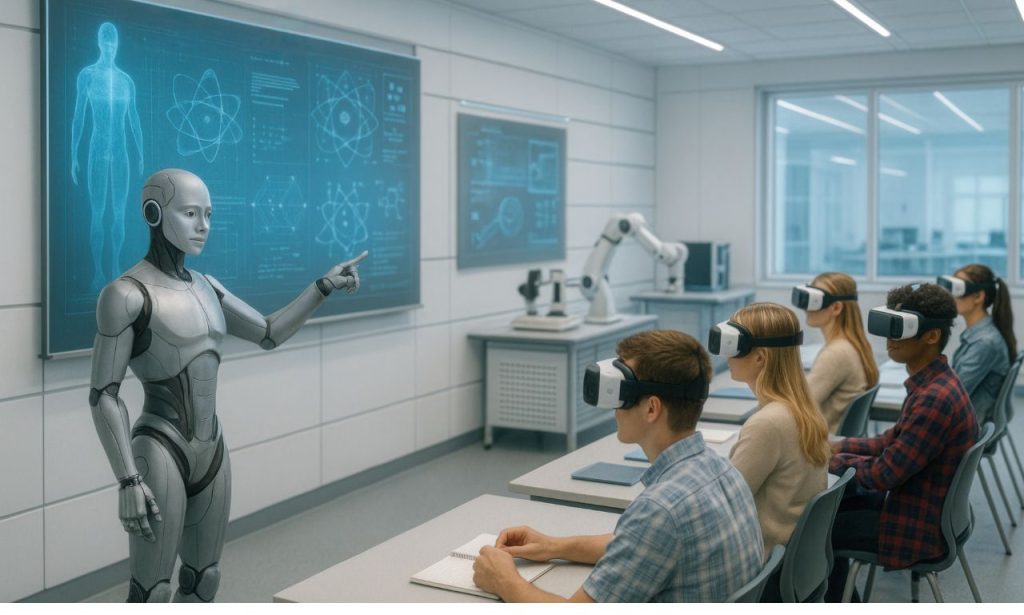Picture this: you’re standing inside a virtual lab, where digital assistants powered by artificial intelligence collaborate with you in real-time. They analyze data, simulate outcomes, and even predict the next step before you act. This isn’t science fiction—it’s the emerging reality of AI agents working seamlessly within Virtual Reality (VR) labs.
AI agents are revolutionizing the way researchers, educators, and innovators conduct experiments. Instead of spending hours configuring virtual environments or crunching numbers, users can focus on discovery and exploration. This shift toward intelligent collaboration between humans and AI within immersive VR spaces is poised to revolutionize scientific inquiry and the creative industries alike.
However, here’s the challenge: how do you effectively integrate AI agents into a VR lab? And what technical, ethical, and strategic hurdles must you overcome? Let’s break down the key insights that will help you build an intelligent, future-ready VR lab.
Practical Applications
AI agents inside VR labs are like having a team of tireless digital colleagues. They don’t just follow commands—they adapt, learn, and enhance the user’s capabilities.
Imagine a medical researcher running surgical simulations. With AI agents, the system can analyze procedural precision, detect errors in real time, and even recommend improvements based on aggregated data from thousands of prior simulations. This not only enhances skill-building but also reduces human error in critical environments.
In engineering, VR labs equipped with AI can automate structural stress tests, model fluid dynamics, or evaluate the efficiency of new prototypes. These AI-driven analyses significantly accelerate research timelines. NASA, for instance, uses VR simulations enhanced by machine learning to train astronauts and test mission scenarios safely before real deployment.
Education also benefits. AI agents can personalize virtual learning experiences by assessing a student’s pace, comprehension, and engagement. A chemistry student, for example, can receive guidance from an AI tutor that understands their weak points and adjusts virtual experiments to match their progress. The result? Learning becomes immersive, interactive, and individualized.
Technical Integration Strategies for Your VR Lab

Now that we know what AI agents can do, let’s get practical. Integrating them into your VR lab requires more than just clever coding—it’s a thoughtful blend of architecture, data management, and UX design.
1. Building an AI-Ready Infrastructure
A successful AI-powered VR lab begins with a solid foundation: computational capacity and real-time data handling. Most setups rely on GPU-intensive systems that can support both AI processing and 3D rendering simultaneously. Cloud services like NVIDIA Omniverse, AWS Sumerian, or Unreal Engine’s ML plug-ins can efficiently scale these processes.
Your goal is seamless synchronization—AI agents must interpret VR user inputs instantly and accurately. Delays break immersion, so data pipelines need to be optimized for low latency. A hybrid architecture that combines edge computing with cloud AI processing often works best for minimizing lag and maintaining real-time interaction.
2. Integrating AI Models into Virtual Environments
Embedding AI into VR requires robust APIs and simulation frameworks that support seamless integration. Developers often use Python-based machine learning libraries (TensorFlow, PyTorch) linked through Unity or Unreal Engine plugins. This integration allows AI agents to perceive, reason, and act within virtual environments.
For instance, an AI-driven lab assistant can use natural language processing (NLP) to interpret voice commands, computer vision to analyze objects in VR, and reinforcement learning to improve task performance. Over time, these agents learn from user behavior, becoming more intuitive and efficient.
3. Data Collection and Training
AI thrives on data. For a VR lab, this means capturing massive streams of user interaction metrics, including gesture tracking, eye movement, decision pathways, and even emotional responses (via biometric sensors).
However, raw data isn’t enough. Training AI agents requires clean, labeled, and contextually relevant datasets. Many institutions use synthetic data generated within VR environments themselves to overcome privacy concerns or limited datasets. This synthetic training approach ensures AI models learn safely and efficiently.
Challenges, Ethical Considerations, and Future Directions
The potential of AI in VR labs is thrilling, but the road ahead is far from simple. Technical, ethical, and societal challenges loom large—and they deserve thoughtful attention.
Addressing Technical Hurdles
Even the best-designed VR systems can stumble when scaling AI integration. Bandwidth limitations, rendering delays, and hardware constraints often reduce performance. The constant need for ultra-low latency—especially in scientific research or surgical training—demands robust edge computing solutions.
Another concern is data security. VR labs generate sensitive intellectual property and personal data. Without encrypted data pipelines and strict access control, AI-driven environments risk exposure to cyber threats. Many labs now use federated learning to mitigate these risks—training AI models locally on secure datasets while sharing only the learned insights, not raw data.
Finally, the interoperability issue. With dozens of software and hardware standards, getting AI tools, VR engines, and user interfaces to work harmoniously can feel like juggling flaming swords. Open-source collaboration and standardized APIs, such as OpenXR, are helping bridge this gap—but the path is still evolving.
Ethical Considerations and Responsible AI
AI agents in VR labs don’t just raise technical questions—they also pose moral and ethical dilemmas.
First, there’s the question of bias. If AI agents are trained on biased datasets, they can replicate or amplify those biases in research outcomes or training simulations. Imagine a healthcare AI trained on data skewed toward specific demographics—it could inadvertently make inaccurate recommendations in VR-based medical training scenarios.
Second, privacy becomes even more complex in immersive environments. Eye-tracking, voice recognition, and motion data can reveal intimate details about users. Responsible VR labs must implement transparent data usage policies and give users complete control over how their information is stored and shared.
Lastly, the human-AI relationship needs clear boundaries. While AI agents can act autonomously, they shouldn’t override human judgment. Researchers should remain in command, with AI serving as a collaborator—not a decision-maker.
The Future of AI-Driven VR Labs
Looking ahead, AI-driven VR labs will redefine how we understand, experiment, and innovate. As both technologies mature, their convergence will spark a new generation of digital exploration.
AI agents will evolve from reactive assistants to proactive collaborators. Picture a VR lab where the AI suggests hypotheses, runs preliminary tests, and visualizes outcomes in 3D before you even put on your headset.
Advances in generative AI and digital twins are expected to accelerate this trend. Virtual replicas of real-world laboratories, powered by AI, will let researchers test materials, medicines, and prototypes in hyper-realistic conditions without physical constraints. It’s a game-changer for industries like pharmaceuticals, aerospace, and energy.
Education, too, will experience a paradigm shift. Universities can host fully virtual labs accessible worldwide, powered by AI tutors that personalize experiments for each learner. This democratization of scientific access could close global research gaps and foster unprecedented collaboration.
Revolutionizing Research with AI Agents in VR Labs
We’re entering an age where the line between imagination and experimentation blurs. AI agents in VR labs are not just tools—they’re catalysts for discovery.
Researchers will soon be able to simulate entire ecosystems, perform real-time genomic analysis, or predict market outcomes using virtual data models. AI’s predictive analytics, combined with VR’s immersion, can dramatically shorten research timelines and reduce costs.
When AI-driven labs reach maturity, innovation will no longer depend solely on physical infrastructure but on creative design and algorithmic insight. This marks a shift from traditional experimentation to immersive innovation—where ideas take shape in digital spaces before entering the real world.
Recap of Key Benefits and Opportunities
Let’s quickly revisit what makes AI-powered VR labs such a powerful evolution:
- Efficiency: Streamlined experimentation and real-time analysis.
- Accessibility: Virtual labs democratize global participation.
- Scalability: Cloud-based AI models allow infinite testing environments.
- Personalization: Adaptive AI agents tailor experiences to users.
- Sustainability: Reduced need for physical materials and travel.
Each of these benefits contributes to faster innovation, deeper collaboration, and broader educational reach. Yet, none of this works without careful planning, ethical safeguards, and a user-first design mindset.
A Call to Action for VR Lab Professionals

If you’re leading a VR lab—or planning to build one—start small but think strategically. Experiment with open-source AI frameworks. Collaborate with data scientists. Prioritize data ethics from the beginning.
Ask yourself: how can AI amplify—not replace—your human expertise? The best implementations are symbiotic, where humans guide the AI’s purpose and AI enhances human potential. It’s time to design VR labs that learn, adapt, and evolve in tandem with their users.
The Path Forward
The next decade will define how AI agents in VR labs transform research, education, and innovation. Early adopters will gain an undeniable edge, setting new standards in how knowledge is created and shared.
By focusing on ethical integration, technical scalability, and interdisciplinary collaboration, institutions can unlock the full potential of this convergence. The opportunity is vast—but it requires vision and responsibility in equal measure.
Conclusion
AI agents in VR labs aren’t just technological upgrades—they’re the foundation of a more innovative, more connected research ecosystem. They empower scientists, educators, and innovators to explore beyond physical limits and imagine what’s next.
The question isn’t whether AI and VR will redefine laboratories—it’s when. And for those ready to embrace this future, the answer is already taking shape inside the headset.
FAQs
They act as intelligent collaborators that analyze data, simulate scenarios, and adapt to users’ needs in real-time.
Healthcare, education, aerospace, manufacturing, and energy sectors all leverage these systems for safer, faster, and more scalable innovation.
Yes—data privacy, bias, and security vulnerabilities must be addressed through strict ethical and technical protocols.
Expect fully autonomous, AI-driven virtual laboratories, where researchers and algorithms collaborate to co-create discoveries across global networks.
Begin with modular AI tools, build an optimized infrastructure, and prioritize responsible data practices from the start.


